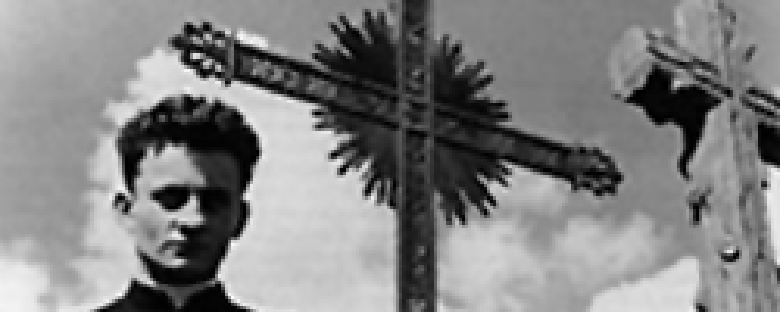Reviews
Le Journal d’un Cure de Campagne
Robert Bresson
France, 1951
Credits
Review by Matt Bailey
Posted on 10 July 2004
Source Kino Video VHS and 35mm print
A young Catholic priest with failing health is assigned to a small country parish, Ambricourt (near the French border with Belgium), where the people seem to have lost their faith and receive the priest with reactions ranging from skepticism to outright hostility. The support of a wise fellow priest and of a suicidal doctor aids him in his ministrations, but as the priest tries to attend to his unenthusiastic flock, his health worsens. In several confrontational encounters with the members of a highly dysfunctional aristocratic family, the priest releases one from soul-tormenting emotional pain while raising the ire and scorn of the rest. Finally, the priest’s health and reputation become so grave that he absconds to the city of Lille to see a doctor. On the way, he is given a ride on a motorcycle by an acquaintance that provides his only moment of pure joy in the film (and perhaps his life). In Lille, the priest is diagnosed with terminal stomach cancer and is attended to by a former seminary colleague and his pure-hearted companion. Just before death, the priest finds mercy and grace and dies with the great weight of humanity lifted from his shoulders.
This first of Bresson’s major works and the first of his films written for the screen by himself was adapted from the acclaimed novel by Georges Bernanos; the film remains a model of adaptation from novel to screen to this day. Bernanos, who died just a few years before Bresson’s film hit screens, and Bresson are a natural fit — both were highly spiritual Catholics who pursued questions of faith and the grace of God in their work but who had little patience for the politics and machinations of the modern Church. Bernanos’ work was often criticized by the Church and the Pope, and Bresson’s film was, for a time, banned in the devout country of Portugal. Bresson’s later film, Mouchette, was also an adaptation of a Bernanos novel.
Bresson’s film is an exceptional example of adaptation from page to screen because of the way he incorporates the words of the priest in voice-over narration, in actual written text visible on the screen, and in dramatizing the action described by the priest in his journal. Bresson emphasizes important turns of events in the narrative by showing them acted out onscreen and then giving the priest a chance to comment on the action through writing in his journal or by speaking the journal writings over the action as it is shown. In this way, the events assume an objective reality in that we see them occur on the screen, but they are enhanced by the subjective narration of the priest, whose interpretation of the events colors how we see them but does so without misleading the audience or commenting ironically on the action.
The film is also a model of adaptation in its economy. Important details are shown visually (or heard on the soundtrack), but not over-emphasized. Whole scenes from the novel are deleted, but only when they are superfluous to the central dynamic of the story. The original cut of the film ran close to 165 minutes — Bresson trimmed 45 minutes, but nothing appears to be lacking in the film. The pace and tone are consistent throughout and the narrative never lags or jumps.
This is also the first of Bresson’s films to employ largely non-professional actors. Claude Laydu, whose performance as the young priest is one of the most haunting portrayals in all of cinema, was cast by Bresson primarily because he was a devout Catholic. Laydu, at Bresson’s behest, spent weeks meditating and starving himself in Normandy before filming to achieve the proper appearance and bearing of an anxious young priest and, for the shooting, wore the actual garments of a priest. Laydu appeared in a handful of other films (his last being a screen adaptation of another Bernanos text, Le Dialogue des Carmélites) but would eventually be most famous in France as a children’s TV show host. André Guibert, who played the kind and understanding priest of Torcy, was a psychiatrist and was rumored to be Bresson’s own analyst. Other actors were seasoned professionals; Antoine Balpêtré, Dr. Delbende in the film, had dozens of screen appearances including the role of another doctor in Henri-Georges controversial Occupation melodrama, Le Corbeau.
Despite the heavy emphasis on the spirituality of this film, it is amazingly effective even to the staunchest non-believer. The incredible hostility and humiliation to which the frail priest is subjected and the magnificent peace he finds just before his painful death is something that can be understood universally. The fact that Bresson chooses to fill the final frames of the film with a shadow of the Cross instead of a histrionic scene of the priest in the throes of death or of people weeping at his grave is not only a religious statement but a deeply profound aesthetic and moral choice.
Bresson’s films, in particular Journal, are often deemed “depressing,” but this is missing the point entirely. The torturous lives many of Bresson’s protagonists lead and their longing for death (conscious or not) is, without question, deeply saddening, but each character, in his or her own way, finds peace and grace in the end — something for which the word “joyous” seems inadequate. Bresson doesn’t deny that life can be, and often is, Hell, but he is careful to demonstrate that there is hope for every one of us, from the most devout to the most skeptical.
We don’t do comments anymore, but you may contact us here or find us on Twitter or Facebook.



